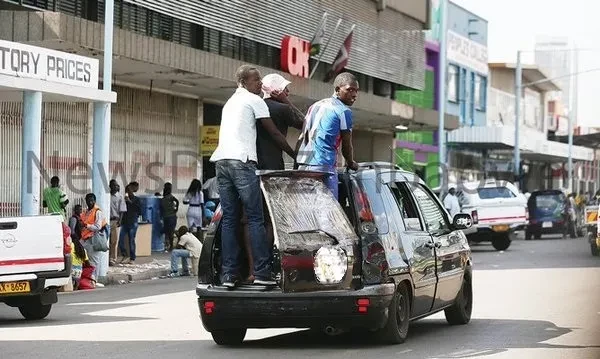
In November 2020, Zimbabwe's government made a bold decision that would significantly impact the country's transportation landscape: it banned all private commuter omnibuses, popularly known as kombis, from operating.
The justification for the ban was twofold.
Firstly, the ban was said to be necessary to control the spread of the Covid-19 pandemic.
Secondly, the ban was claimed would help to formalise the kombi industry and improve safety standards.
However, the ban was met with widespread criticism from the public.
Many argued that the ban would create a public transport crisis, as kombis were the primary mode of transportation for many Zimbabweans.
Additionally, critics pointed out that the government had not provided any adequate alternative transportation options.
In response to the public outcry, the government partially reversed the ban in May 2022, allowing some kombis to operate under the Zimbabwe United Passenger Company (Zupco) franchise.
- Police intensify crackdown on pirate taxis
- Govt moves to restore sanity on Harare roads
- Govt must sort out traffic jams
- Mupfumi loses US$52 000 to armed robbers
Keep Reading
However, this did not alleviate the public transport crisis, as the number of kombis operating under the Zupco franchise was significantly lower than the number of kombis that had been operating before the ban.
The ban on kombis inadvertently created a worse transportation nightmare in the form of mushikashika vehicles.
These unlicensed and unregulated vehicles, reminiscent of the Peugeot 405 and 505 pirate taxis of the early 1990s, have flooded the streets of Harare, causing chaos and posing a significant risk to both passengers and pedestrians.
The mushikashika phenomenon is not without its roots.
The kombi ban, though initially temporary, has created a vacuum in the public transportation sector, leaving many Zimbabweans stranded without reliable and affordable means of getting around.
This void has been exploited by mushikashika operators, who have seized the opportunity to fill the gap, albeit in a haphazard and unregulated manner.
These vehicles, often in a dilapidated state and driven by reckless individuals, disregard traffic rules and regulations, weave through traffic, stop abruptly, and overload passengers.
This reckless behaviour has led to numerous accidents and injuries.
The dangers of mushikashika extend beyond their chaotic driving habits.
The lack of regulation and oversight means that these vehicles are not subjected to safety inspections or maintenance procedures, further increasing the risk of accidents.
Additionally, the absence of proper identification and tracking systems makes it difficult to hold mushikashika operators accountable for their actions.
In September 2023 the ‘Operation Tame the Traffic Jungle’ was introduced countrywide to bring sanity on the roads; sanity which was short-lived.
The operation's shortcomings can be attributed to several factors.
Firstly, its focus on enforcement rather than prevention failed to address the root causes of the mushikashika phenomenon, which stem from the lack of affordable and reliable public transportation options.
Secondly, the operation's reliance on temporary measures, such as roadblocks and spot checks, was ineffective in deterring mushikashika operators in the long run.
As a result of the operation's fleeting success, the average Zimbabwean who relies on public transportation was left bearing the brunt of the mushikashika menace.
While those driving their own vehicles may have experienced some temporary relief, the operation left the majority of Zimbabweans vulnerable to the dangers and inconveniences of mushikashika.
What we continue to see is that even after the lifting of the ban and introduction of police operations, reliable public transport remains a challenge.
Although shortage of transport affects the majority of citizens, women and children remain the most vulnerable and most affected.
In a nutshell, Zimbabwe continues to face three urgent transport challenges: the country has a high rate of road fatalities, high transport costs and the unavailability of a reliable and safe public transport system.
In November 2023 alone these are some of the news headlines we have seen:
- 40 people were injured when a CAG bus veered off the road and overturned along Bulawayo-Victoria Falls Road
- Marondera-Murewa road accident claims two lives
- Six people including a driver died in two separate road traffic accidents, which occurred in the Midlands province.
- Three people killed in Gokwe accident.
- Two people died on the spot while several others were injured after an InterAfrica bus burst a tyre and overturned along the Bulawayo-Victoria falls road.
- Six people perished on the spot while three others were critically injured after a kombi they were travelling in collided with a haulage truck along the Beitbridge-Masvingo highway.
- Twenty-two people were killed after an overloaded Toyota Quantum had a head-on collision with a DAF along the Bulawayo-Beitbridge Road.
These are just the accidents reported in mainline media in two weeks, but there are many more which go unreported but are equally as important to take note of.
Multiple factors contribute to this grim statistic.
Dilapidated roads, lack of road safety regulations, and reckless driving habits all play a role in the high number of road accidents.
Furthermore, the inadequate enforcement of traffic laws and the absence of emergency medical services along major highways exacerbate the situation.
In Harare, it’s not only umbrella prices that are hiked when it starts raining, it’s the same with public transport.
Add there being different rates for the same route – all determined by the time of day. High transport costs have a significant impact on women and girls in Africa, limiting their mobility, access to education and healthcare, and economic opportunities.
The high cost of transportation also hinders economic growth and productivity.
Businesses are forced to factor in inflated transportation costs into their pricing models, ultimately contributing to a higher cost of living for all Zimbabweans.
This vicious cycle perpetuates poverty and limits the country's economic potential.
In addition, high transport costs can make women and girls more vulnerable to violence.
This is because they may be forced to walk alone in unsafe areas, or they may be more likely to take public transportation, where they may be harassed or assaulted.
The absence of reliable public transportation forces many to embark on long walks, exposing them to the perils of criminal activity, including gender-based violence.
While the lack of transportation has been a focal point in urban areas, its impact extends far beyond city limits, deeply affecting women and girls in rural communities.
The absence of adequate transport leaves them stranded, unable to commute to healthcare centers or access basic services like banking.
What have we heard so far? (2019-2022)
Belarus has offered Zimbabwe a facility of 500 buses to modernise its mass public transport system (The Herald, January 2019)
Commuter rail passenger train introduced in Harare (The Herald, September 2021)
Commuter rail passenger train introduced in Bulawayo (The Chronicle, November 2021)
115 new Zupco buses commissioned, with 432 now added to the fleet in just over two years (The Herald, June 2022)
The question is where are we now and what is the progress?
To overcome these transport challenges, Zimbabwe must adopt a comprehensive and strategic approach.
Investing in infrastructure development, including road repairs and the construction of new roads, is crucial to reducing road accidents.
Additionally, stricter enforcement of traffic laws, coupled with public awareness campaigns on road safety, can help curb reckless driving habits.
Enhancing the reliability and safety of public transportation demands a multi-pronged strategy.
Modernising the bus fleet, expanding bus routes, and implementing efficient scheduling systems are essential steps.
Moreover, stricter oversight of informal transport operators and the implementation of safety standards can minimise the risks associated with these modes of transportation.
Zimbabwe's transportation challenges disproportionately affect women and girls, hindering their mobility, safety, and access to essential services.
To address these issues, Zimbabwe must implement effective and inclusive transportation solutions that prioritise the needs of women and girls. This includes investing in infrastructure, enacting policy reforms, and engaging with communities.
By prioritising the voices of women and girls in transportation planning, Zimbabwe can create a more equitable, inclusive, and prosperous society.
*Madamombe is a communications specialist with deep understanding of women and gender issues. She has a passion for creating content that is informative and thought provoking. She holds a Master's in International Public Policy and Diplomacy
These weekly articles are coordinated by Lovemore Kadenge, an independent consultant, managing consultant of Zawale Consultants (Private) Limited, past president of the Zimbabwe Economics Society and past president of the Chartered Governance & Accountancy Institute in Zimbabwe. Email- kadenge.zes@gmail.com or Mobile No. +263 772 382 852









